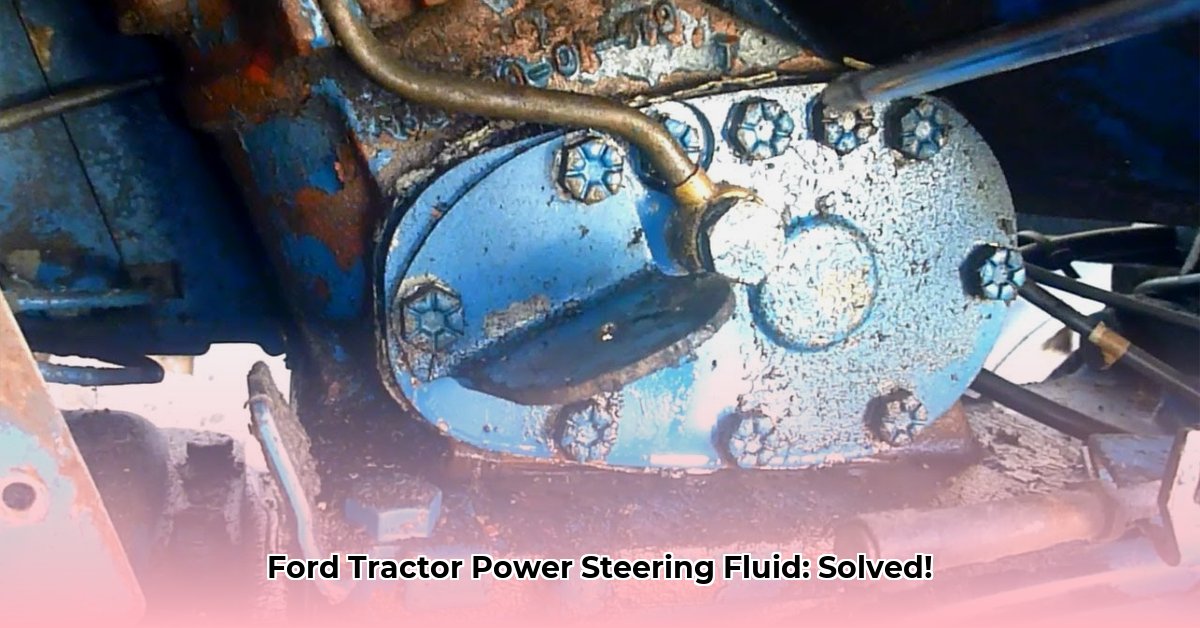
Understanding the Power Steering Fluid Dilemma
Choosing the correct power steering fluid for your Ford tractor can be surprisingly complex. Online advice often contradicts itself, leaving owners uncertain about which fluid is safe and effective. This guide provides clear, step-by-step instructions to help you select and change your power steering fluid, ensuring your tractor's smooth operation. We'll address the common confusion surrounding ATF and M2C41/NH 134D fluids, offering a straightforward approach to solving this common problem. For more Ford tractor specifications, check out this helpful resource.
Understanding Your Fluid Options: ATF vs. M2C41/NH 134D
Two primary fluid types contend for your Ford tractor's power steering system: Automatic Transmission Fluid (ATF) and the specialized hydraulic fluid, originally designated M2C41 by Ford (now often superseded by NH 134D, or equivalent formulations from other manufacturers like Valvoline #813). These fluids have distinct chemical compositions and performance characteristics.
ATF, designed for automatic transmissions, prioritizes smooth shifting. While sometimes used in older Ford tractor power steering systems, its properties might not always offer optimal protection or performance in the more demanding environment of a tractor's power steering unit.
M2C41/NH 134D (and equivalents), however, is formulated for heavy-duty hydraulic systems. It's engineered to withstand higher pressures and protect components against wear and tear under intense operational stresses. This makes it generally a more suitable choice for the power steering systems in many Ford tractors, particularly newer models or those used in demanding applications.
Using the wrong fluid can lead to problems ranging from sluggish steering and reduced efficiency to premature component wear and potential system failure. Selecting the right fluid is crucial for maintaining your tractor's power steering system's longevity and performance.
Choosing the Right Fluid: A Step-by-Step Decision Tree
Determining the correct power steering fluid for your Ford tractor involves a methodical approach:
Consult Your Owner's Manual: Your owner's manual is the definitive guide for your tractor model. It will specify the recommended fluid type and specifications. This is the most reliable source of information.
Check Existing Fluid (If Possible): If you can safely inspect the current fluid, note its type and condition. This information helps determine whether a complete fluid change is necessary or if topping off with the correct fluid is sufficient.
Prioritize Compatibility: If mixing fluids is unavoidable, M2C41/NH 134D or its equivalent tends to offer better compatibility with other suitable fluids than ATF. However, always strive to use only the manufacturer-recommended fluid whenever possible.
Identify Suitable Alternatives: Valvoline #813 and Universal Tractor Fluids (UTFs) within an appropriate viscosity range (typically 10W-30W) can often function as suitable replacements for M2C41/NH 134D, provided they meet the specified requirements for your tractor model. Always check compatibility charts to ensure proper usage.
Changing Your Power Steering Fluid: A Practical Guide
Always prioritize safety. Disconnect your tractor's battery before starting any fluid changes. Wear appropriate safety glasses and gloves to protect yourself from spills.
Locate the Reservoir: Identify the power steering fluid reservoir. Its location will vary depending on your tractor model; consult your owner's manual if necessary.
Drain Old Fluid: Carefully drain the old fluid into a designated container. Dispose of this used fluid according to local regulations for used oil or hazardous waste.
Clean the Reservoir: Clean the reservoir of any sediment or debris using clean rags or shop towels. A quick rinse with a compatible cleaning solvent might be beneficial. Refer to your owner's manual for specific instructions.
Fill with New Fluid: Add the correct power steering fluid to the reservoir, adhering to the recommended fill level specified in your owner's manual.
Bleed the System: Reconnect the battery. Start the tractor and turn the steering wheel fully from lock to lock several times to remove air bubbles from the system. This ensures efficient fluid circulation and optimal power steering function. Monitor and top off fluid level as needed.
Maintenance and Troubleshooting: Proactive Measures
Regular maintenance extends the life of your Ford tractor's power steering system. Don't neglect these important steps:
Regular Fluid Level Checks: Check your fluid level frequently. Low levels can lead to overheating and pump failure, necessitating costly repairs.
Prompt Leak Repair: Address leaks as soon as you discover them. Small leaks can quickly escalate into significant problems, contributing to costly repairs and potential system failure.
Preventative Maintenance: Regular servicing by a qualified mechanic will help prevent problems before they occur.
Frequently Asked Questions (FAQ)
Q: Can I use car power steering fluid in my Ford tractor? A: Generally, no. Automobile power steering fluids are often formulated differently and may not be compatible with your tractor's system. Using incorrect fluids might damage your system.
Q: My manual specifies ATF. Should I still use it? A: Older manuals might recommend ATF, generally Type A. However, for the optimal performance and longevity of modern Ford tractor power steering systems, M2C41/NH 134D or equivalent hydraulic fluids are typically a safer choice. Always consult the manual to determine what is correct for your specific model and age of tractor.
This guide offers general guidance. Always refer to your tractor's owner’s manual for model-specific instructions and recommendations. Consistent maintenance and using the correct fluid will ensure the continued smooth operation of your Ford tractor's power steering system.